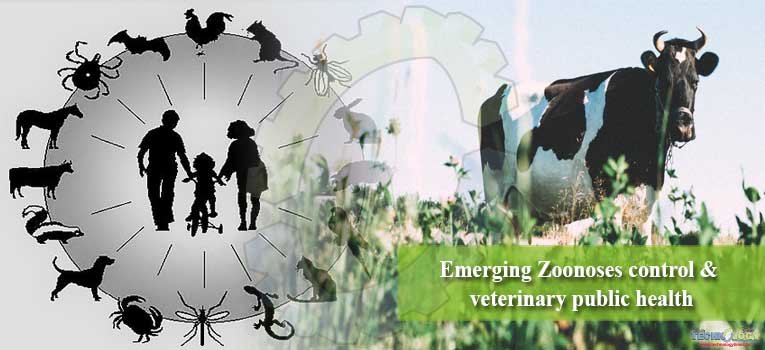Zoonoses: Term used to refer transmission of diseases from animals to humans and humans to animals occasionally.
 Zoonotic: Are the diseases (infectious) caused by certain bacteria, viruses and other microorganisms which are transmissible from animals to humans and vice versa.
Zoonotic: Are the diseases (infectious) caused by certain bacteria, viruses and other microorganisms which are transmissible from animals to humans and vice versa.
These terms are neglected in daily life and nobody cares about these things. But if these diseases go unnoticed they will result in serious and irreversible harms to humans and animals. In these decades major zoonotic diseases are Ebola virus and Salmonellosis.
Human immune deficiency virus (HIV) was known as zoonotic disease but in 20th century it was mutated as separate human-only disease. Many types or strains of influenza that infect humans are disease of humans. Swine and bird flu are zoonotic now days.
These strains combine with strains of human flue and cause pandemics such as Spanish flue (1918) and swine flu (2009). In many regions Taenia solium is one of neglected zoonoses of tropical areas with public health and veterinary concern. Out of 1415 pathogens 61% were found to be zoonotic.
Zoonoses have direct and indirect mode of transmission. In direct mode the disease is transmitted from animal to human through media such as saliva or bite of that animal.
In indirect transmission there is involvement of intermediate host or species which carry the pathogen without getting the infected. When disease is transmitted from humans to animals it is called as reverse zoonoses or Anthroponosis.
CAUSES
Zoonotic transmission can occur in many ways like from companion animals (pets), consuming animal’s byproducts, research contact or non-human animal’s derivatives (vaccines).
CONTAMINATED FOOD AND WATER
The most well known pathogens causing food borne diseases are E.coli, Campylobacter, Caliciviridae, and Salmonella
In Berlin a conference was held which was focusing on issue of zoonoses effect on food safety boosting the government and public to intervene and the public to be observant towards the risk of catching food borne diseases from farm to dining table.
Some common foods which can be linked to zoonotic diseases are eggs, sea foods, fish, animal meat and milk and some vegetables.
LIVESTOCK FARMING AND ANIMAL BREEDING
People dealing with animals on farms or in research purposes are at greater risk of zoonotic diseases. People who work closely with horses can get Glander’s infection. Those working with cattle are at risk of cutaneous anthrax infection and inhalation anthrax infection is common in people working in slaughterhouses or abattoirs.
Clamydiosis or abortion in pregnant women can be result in close contact with the sheep that have recently given birth. Also an increases risk of toxoplasmosis, listeriosis in pregnant and or immuno compromised animal or human
Practicing veterinarians are continuously at risk of getting zoonotic infections because they are exposed to unique occupational hazards. In the United States study have revealed that there is an increases chances too injuries and lack of veterinary awareness to these hazards.
Research also proved the importance of continued clinical veterinary education on occupation risks associated with musculoskeletal injuries, animal bites, needles, and cuts.
WILD ANIMALS ATTACK
- Rabies
Is very dangerous disease which involves central nervous system. In this disease animal or humans become vicious and uncontrollable. The only solution in this condition is to shoot the animal. The dog in the following picture is Rabid
- Pets
Pets can be the source of many zoonotic diseases like Rabies, Ringworm , Giardia. These are endemic in animals and humans populations. Toxoplasmosis can be fatal to the pregnant woman which is a common disease of cats.
Cat scratch disease is caused by Bartonella henselae and Bartonella quintana from fleas. It is also endemic in cats. Toxocariasis also spread to humans from different Dog specific species of roundworms like Toxocara canis and Toxocara cati
- Exhibition
Outbreaks of zoonoses have been reported from exposure of humans to animals in fairs, petting zoos, dog shows and other events related to animals.
Center of disease control and prevention has issued updated list of recommendations for preventing zoonotic diseases in public.
CONTROL AND PREVENTION OF ZOONOSIS AND VETERINARY PUBLIC HEALTH
As we know zoonotic diseases affect both humans and animals so both medical and veterinary agencies have a large stake in surveillance and control of disease. Coordination between agencies is very important and are time consuming and required determination, dedication and long time planning for control activities.
- Control of zoonotic diseases
It is a very important goal of VPH. When all possible control measures are applied the result will be good. Quarantine measures are very important to minimize the risk of zoonoses.
Test and sestruction of diseases animals as in case of brucellosis , leshminiosis, glanders, salmonellosis, and bovine tuberculosis is very important in control measures.
- Test and segregation for leptospirosis
Immunization in animals who are exposed to diseases, vaccination campaigns greatly help in control of diseases like brucellosis equine encephalomyelitis, leptospirosis, rabies, Rift Valley fever, salmonellosis.
- Treatment of infected animals
1- Restriction of animal movements is very important in dealing with zoonoses.
2- Control of animal population such as of dogs, cats, foxes as well as arthropods is also important.
3- The prohibition to slaughter diseases animal is important in control of certain diseases like brucellosis , glander and anthrax.